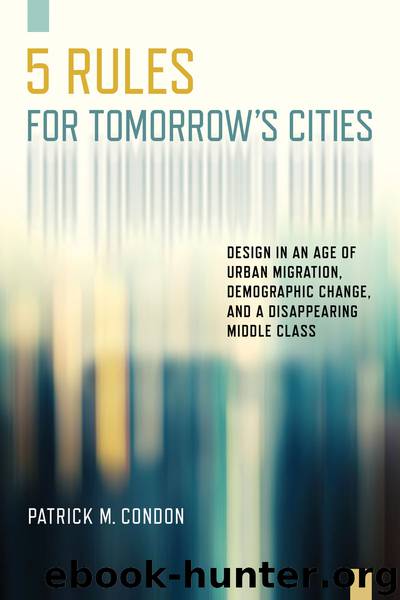Five Rules for Tomorrow's Cities by Patrick M. Condon

Author:Patrick M. Condon
Language: eng
Format: epub
Publisher: Island Press
Published: 2019-03-12T16:00:00+00:00
Conclusion
In the developed world we seem to have been drawn into spending too much on infrastructure, an infrastructure that seems to produce a dollar’s worth of environmental damage for each dollar spent. Much of this infrastructure is there to support our use of private automobiles. But even there our standards are excessive. To make it even more odious, this generation of taxpayers, taxpayers who on average have less disposable income than their parents, will be asked to foot the long-delayed bill for its upkeep and reconstruction. A strategy that seeks to reduce the sheer weight and expense of our infrastructure is needed. We are already seeing roads returned to gravel and underused freeways torn down. Our next steps will probably include downsizing and rethinking our suburban infrastructure when we can no longer delay its repair.
One hopes that we might also realize that we have only a decade to retrofit our entire transit system to accommodate far more users without increasing levels of greenhouse gas. Failure to do so leads to unconscionable environmental collapse, so failure is not an option. In this we must spread our ever-scarcer public dollars more broadly, favoring the cheap, accessible, and slower over the expensive and inaccessible but faster subway or elevated transit systems (for example). It’s nice to arrive five minutes faster, but not at the expense of a dead planet.
In this arduous task, informal communities have much to teach us. Their typically high-intensity, small-block, narrow-street environments, for all their shortcomings, are certainly inexpensive. And indeed, their shortcomings are much more easily rectified than are the deadly flaws of the tragically oversized and ultimately unaffordable infrastructure of the developed world.
Urban designers wrestling with the tumultuous changes to world cities precipitated by the three great waves will best serve their clients, their cities, and their planet by incorporating this LGSI principle, not just in their work but literally in the way they see the world. In previous chapters we have examined the complexities of the interlocking elements of the materials, processes, form, and meaning of the city, made manifest in the systems of work, community, ecology, and movement. We furthermore have explained how the city is also a network made manifest, most importantly in simple things such as road networks and how they influence living. Now we point to humble infrastructure with the same intention. You see, infrastructure is not so humble after all. Infrastructure is the most obvious manifestation of the human hand in the world; it is the street outside our door. It is best if it is built in a way that respects the urgency of making the world a productive, sustainable place. If it can do this well, it results not just in financial savings but in the thing we call beauty. For urban designers to access this kind of beauty requires a mental separation from the world as taken for granted—almost a capacity to hallucinate—to finally see the wonder in a rivulet, in a ball bouncing off a wall, in the suitability of the gliding tram to a forever sustainable city.
Download
This site does not store any files on its server. We only index and link to content provided by other sites. Please contact the content providers to delete copyright contents if any and email us, we'll remove relevant links or contents immediately.
Kathy Andrews Collection by Kathy Andrews(11731)
The remains of the day by Kazuo Ishiguro(8826)
Paper Towns by Green John(5092)
Spare by Prince Harry The Duke of Sussex(5074)
Industrial Automation from Scratch: A hands-on guide to using sensors, actuators, PLCs, HMIs, and SCADA to automate industrial processes by Olushola Akande(4985)
The Body: A Guide for Occupants by Bill Bryson(4975)
Machine Learning at Scale with H2O by Gregory Keys | David Whiting(4185)
Be in a Treehouse by Pete Nelson(3951)
Never by Ken Follett(3794)
Harry Potter and the Goblet Of Fire by J.K. Rowling(3775)
Goodbye Paradise(3728)
Into Thin Air by Jon Krakauer(3313)
The Remains of the Day by Kazuo Ishiguro(3295)
The Cellar by Natasha Preston(3262)
The Genius of Japanese Carpentry by Azby Brown(3226)
Fairy Tale by Stephen King(3220)
120 Days of Sodom by Marquis de Sade(3182)
The Man Who Died Twice by Richard Osman(2997)
Drawing Shortcuts: Developing Quick Drawing Skills Using Today's Technology by Leggitt Jim(2996)
